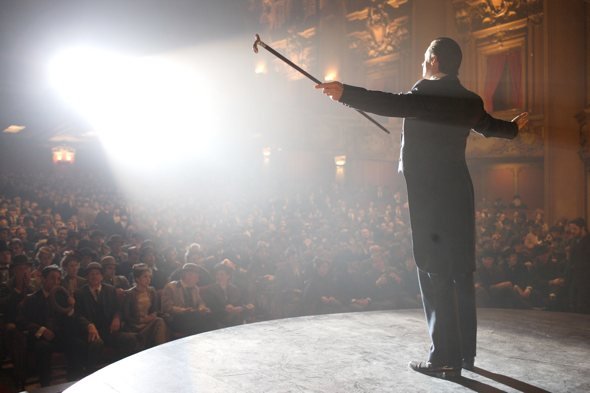At one point in The Prestige, Christopher Nolan’s 2006 film about the rivalry between two magicians in 1890s London, Borden (Christian Bale) criticises a rival who has reached the top and lost his edge: “Milton’s got success, whatever that means, and now he’s scared, he won’t take any risks at all. He’s squandering the goodwill of the audience with these tired, second-rate tricks…”
That line might be read as an open challenge from Nolan to his rivals in mainstream popular cinema – that high-wire tradition whose reputation he has been upholding since he first captured attention with his second feature Memento in 2000. Each of Nolan’s films since that breakthrough courts the mass audience, while also demanding its concentration. This respect for the engagement of his fans seems integral to the director’s approach. In the era of Transformers, where much of mainstream cinema treats its audience with open contempt, Nolan’s approach amounts to a moral stance, one that audiences have responded to – helping to explain the heart-in-mouth levels of anticipation among his fans for his new film The Dark Knight Rises.
The sheer ambition of Nolan’s work has forced other blockbuster filmmakers to re-evaluate their process, leaving many floundering in his wake (Ridley Scott’s Prometheus, for one, seems facile and ineffectual in comparison). Playing like superior airport novels with complex structures, Nolan’s films unite members of different audiences who seek escapist entertainment but are weary of patronisation and pretension. His films allow arthouse regulars to enjoy superhero flicks and multiplex crowds to engage with labyrinthine plot conceits.
The technical virtuosity of his work makes it hard to believe that Nolan bypassed film school, but he did, making his first films – sci-fi mini-epics peopled by action figures – on super 8. While studying English at University College London in the early 1990s, he used whatever film technology was available, going on to collaborate with friends and his regular producing partner Emma Thomas (his wife since 1997) on the inventive short Doodlebug (1997) and his debut feature Following (1998). Both films gained critical plaudits and attention on the festival circuit, but it was his second feature, the radically structured Memento – starring Guy Pearce as an amnesiac on the hunt for his wife’s killer, relying on notes to himself for knowledge of what’s happened – that was his breakout commercial success. His first US film, it also marked the start of his collaboration with Wally Pfister, the American DP with whom he has worked ever since.
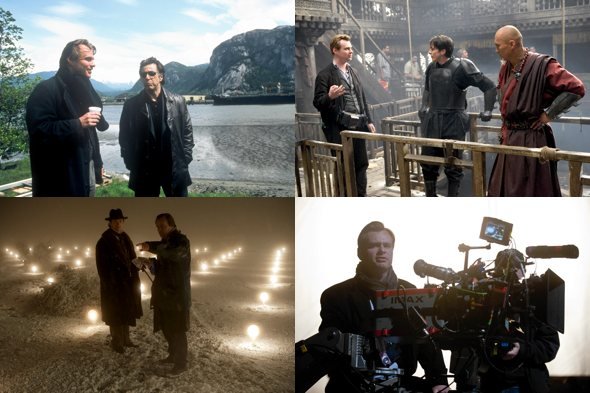
Christopher Nolan directing (clockwise from top left): Insomnia; Batman Begins; The Dark Knight Rises; The Prestige.
Nolan’s subsequent career has been a vertical ascent. First came Insomnia (2002); a remake of a Norwegian noir, it starred Al Pacino as Will Dormer, a corrupt cop adrift in a nightless Alaska. Its success gave Nolan the clout to commandeer what was, at that point, a franchise in ruins: DC Comics’ Batman. Nolan’s Batman Begins (2005) helped erase the memory of Joel Schumacher’s debacles Batman Forever (1995) and Batman & Robin (1997) by turning to the character’s origins as portrayed in Frank Miller’s dark, avowedly serious graphic novel Batman: Year One, first published in 1987.
Following The Prestige, adapted from the 1995 novel by Christopher Priest, Nolan’s 2008 Batman sequel The Dark Knight proved his biggest box-office hit to date, aided by a barnstorming performance from Heath Ledger as the Joker. Its huge success gave Nolan creative carte blanche for his next film, the complex and ambitious Inception (2010), in which a corporate espionage group led by Leonardo DiCaprio’s Dom Cobb penetrates people’s dreams to steal (or impart) secrets. And this summer, of course, Nolan returns for the final part of the Batman trilogy The Dark Night Rises.
Though the scale of the canvas has increased hugely since Memento, what’s remarkable about Nolan’s recent films is that they’ve all retained the noir-ish gleam, thematic obsessions and technical daring of his earlier work. The charge most often lobbed at Nolan is that he is primarily a ‘technical’ filmmaker. His films are said to be cold, and somehow lacking in the sense of personal revelation that is the stamp of a true auteur. But another way of looking at it is to suggest that they dissolve the boundaries between a populist and a private cinema. The epithet ‘fanboy’, thrown around derisively by critics and filmmakers assailed by the web hordes, may be the key to understanding Nolan. The director is arguably both the fanboy’s fanboy and the redeemer of that derogatory tag, able to wrest the wonder of adolescent imagination back from the cynical and the hyper-critical.
In keeping with the fan’s perspective, a strong element of wish-fulfilment informs Nolan’s work – a desire to cram in as much ‘cool stuff’ as possible. His films teem with ninjas, superheroes, secret agents, tanks, corporate spies, magicians, stalkers and omnipresent guys-in-suits-with-guns. But all these elements are approached with a resolute seriousness. In this respect Nolan’s regular script collaboration with his younger brother Jonathan (who wrote the original story of Memento, and co-wrote the screenplays of The Prestige, The Dark Knight and The Dark Knight Rises) is telling; their films seem to emanate from a shared imaginative dream-world, an environment of closeted yet liberating enthusiasm.
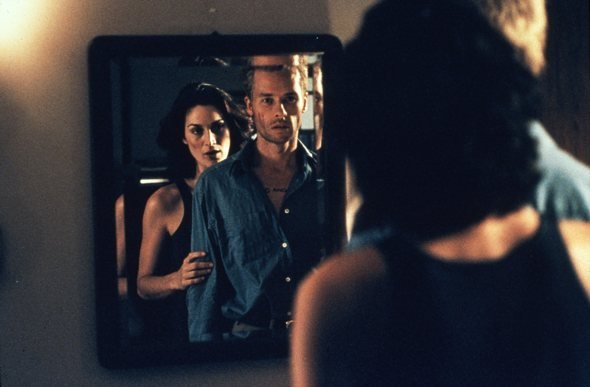
Memento (2000)
How you react to Nolan’s recent work depends on the degree to which you consider the term ‘adolescent’ to be pejorative; certainly, there’s an inhuman blandness to the Nolan dream-landscape – an unworldly, sexless atmosphere. In Inception, the arrival of gun-toting goons in the target’s dream prompts the comment that the target’s “subconscious has been weaponized”. The line might suggest an untamed id gone wild, but the result is in fact a radical reduction of possibilities to machine guns, explosions and car crashes. The subconscious here has been infantilised.
This Peter Pan-like sense of never growing up is reflected in his choice of actors. Leonardo DiCaprio, Joseph Gordon-Levitt, Heath Ledger and Christian Bale were all child actors, and they present a boyish, svelte and resolutely un-blokeish masculinity. Nolan’s preferred male characters are all techno–savvy fussy dressers. In Inception, Tom Hardy’s Eames is presented as a Bond-like anachronism, mocked for his ruggedness, just as Bale’s push-up routine draws a resigned smile from Michael Caine in Batman Begins. Inception is probably the first guys-on-a-mission movie peopled by internet creatives – a blockbuster action movie with man-bags.
But if Nolan’s work is refreshingly light on machismo, it has little place for complex female characters either. Women remain stuck in the original archetypes of the femme fatale, the victim or the doe-eyed ingenue. Some of the actresses employed by Nolan manage to infuse his women with more interest (particularly Rebecca Hall in The Prestige), but others (such as Maggie Gyllenhaal in The Dark Knight) struggle in underwritten parts. The fear of empowered femininity that runs through Nolan’s films is perhaps a hangover from the noir tradition. Any suggestion of aggressive sexuality or vulgarity tends to indicate corruption – as with Carrie-Anne Moss’s traitorous ally in Memento, or the slutty schoolgirl in Insomnia who is punished for her licentiousness by Pacino. Nolan’s women, it seems, are only to be longed for, mourned or mistrusted.
The adolescent’s need for protection from human venality – and the near impossibility of finding it – ties in with Nolan’s disavowal of cynicism in the moviemaking process. He’s spoken of his desire to “portray dreams on film”, but the attendant irony is that his dreams – and by extension, those of his audience – are themselves colonised by films. Nolan channels the co-opted imaginative life of the 1980s teenager, the delineation and exploration of one’s own imagination through the prism of popular culture – the video shop, the comic shop, the film magazine. The young Orson Welles called Hollywood “the biggest electric train set a boy ever had”; in the rain-drenched initiating dream that is Inception’s finale, a gigantic train appears from nowhere in the middle of a busy street. This sort of thing is part of the charm of Nolan’s work: an open acknowledgement of his own sense of wish-fulfilment, which brings him that much closer to his audience.
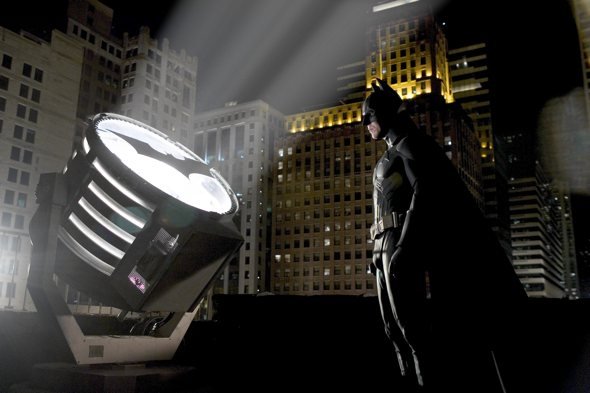
Batman Begins (2005)
Escapism is both Nolan’s greatest strength and a point of weakness, because it could be read as a refusal of any radical action in the real world. The closing words of The Dark Knight – “Sometimes the truth isn’t good enough. Sometimes people deserve more” – could stand as that film’s argument, and indeed Nolan’s mission statement as a whole, but it could also be seen as a reactionary sentiment in a film that presents the general public as a dangerous mob of complainers only seconds away from panic and murder, who in order to avoid chaos must be manipulated by politicians, policemen, heroes and millionaires. As Slavoj Zizek has pointed out, The Dark Knight is an expression of “the undesirability of truth” – as good a definition of escapist entertainment as one might wish for.
And indeed the ‘undesirability of truth’ can be seen as Nolan’s key theme, addressed in all his films – its roots lying in a fear of what might occur when the fragile codes that stop (in the Joker’s phrase) “civilised people from eating each other” are broken. Those who violate these codes have been figures of fear in his work since the start. Following was influenced by Nolan’s experience of having his London flat broken into; Memento is a nightmare about the loss of control, as is Insomnia; The Dark Knight is about the sacrifices necessary to maintain control. The thuggishly villainous figure of Bane (Tom Hardy) in The Dark Knight Rises is another embodiment of this fear.
Guarding against this loss of control often entails moral compromises. Nearly all of Nolan’s films include a scene where the heroes entrap and torture antagonists in order to achieve a moralised goal. Nolan seems to suggest that it’s a human being’s ability to fictionalise himself – to practise a performative morality, to make themselves into whatever they need to be – that redeems them. This self-realisation involves a choice. In Inception, Cobb’s renunciation of his dream inamorata is a choice between one lie and what might possibly be a further lie: the catharsis of the unification with his children. In the same way, Memento’s Leonard Shelby (Guy Pearce) deliberately uses his amnesia to fool himself into comforting delusions – literally to forget the truth.
In Nolan’s films, the only hope seems to be the hope of escape. Instead of the recycled Jesus myth present in many action-genre films, he uses mainstream cinema to describe an insoluble bind between pessimism and idealism.
Cultural resonances
Though Nolan’s films stay within the boundaries of his boyhood obsessions – which clearly include the work of other filmmakers – the cultural resonances of his films reach beyond cinema. In the comics and graphic novels of the 1980s and 90s he found a sense of imaginative playfulness that is the most obvious precursor to his own writing, and his films reintegrate that world into mainstream cinema.
This penchant for reinvigorating generic tropes, cross-fertilising genres and manipulating narrative structures puts him well within a British tradition that includes the comic 2000 AD, and in particular Alan Moore’s Future Shocks strips, with their emphasis on meticulously imagined worlds and distortions of time and space. Likewise The Prestige uses imagery that harks back to the steampunk Victoriana of another 2000 AD staple, Nemesis the Warlock.
From the US, Frank Miller’s aforementioned Batman: Year One formed the urtext for Batman Begins, while Miller’s 1986 graphic novel The Dark Knight Returns was an inspiration for Nolan’s sequel. Where Miller’s innovation was to graft the tropes of hard-boiled crime fiction onto the superhero narrative, Nolan’s film seamlessly blended the tonalities of the cinematic crime epic – primarily Michael Mann’s Heat (1995) – with the conventions of the superhero movie.

The Dark Knight (2008)
As a teenager in the 1980s, Nolan must also have experienced videogames. While it’s hard to imagine him adding to the regrettable lineage of video-game film adaptations, he has paid direct homage to newer games in his last two films. The elevated shots of Bruce Wayne’s speeding Lamborghini in The Dark Knight mimic the player’s view in Grand Theft Auto, while Inception’s infiltration of a snow-bound compound echoes the Splinter Cell games, as well as the Japanese game Metal Gear Solid.
These resonances also occur at script level. Inception’s dream levels are structured like the levels of a game, while Memento – with its emphasis on a lone hero picking up clues while working his way around strange environments – is reminiscent of myriad point-and-click adventures. Nolan may be the first director to openly acknowledge the challenge mainstream cinema faces from the videogame industry, and to reaffirm that the movies can be equally immersive and involving for the console generation.
Nonetheless, this forward thinking (which includes groundbreaking use of IMAX technology) is balanced by a traditionalism. Nolan has spoken of his loyalty to using film, and has yet to employ digital cameras – though he says this is simply because he prefers “clear, clean images, without filtration”. Though he will use CGI discreetly, he tends to end any sequence in which it’s used with live-action effects, in order to ‘re-ground’ the film in an aesthetic reality.
Nolan’s production company, whose logo is a centreless maze, is called Syncopy, referencing the medical condition syncope, or temporary loss of consciousness. In the dream state created, the audience is asked to be creative, to wonder at possibilities, to formulate their own opinions as to the meaning of the film.
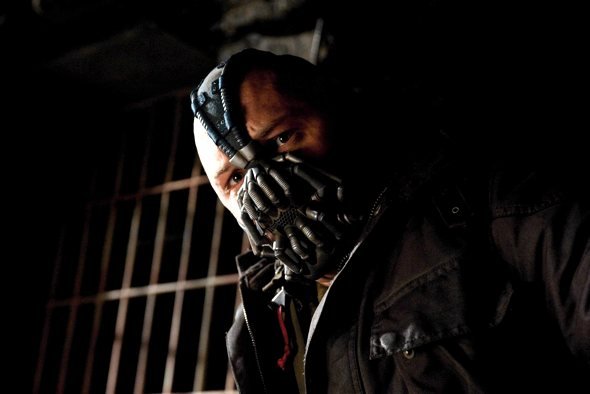
The Dark Knight Rises (2012)
Nolan’s cinematic influences, meanwhile, seem significant primarily on a visual level: Ridley and Tony Scott, with their atmospheric sheen and opulent production design; Stanley Kubrick for his epic scale and landscapes; Michael Mann, whose architectural stylings in Heat and Collateral (2004) gave The Dark Knight weight; and even Michael Bay, with his shiny, chromatic look, pounding scores and elliptical editing style.
Yet the closest comparison might be to Terry Gilliam, whose visionary worlds have much in common with Nolan’s – albeit with whimsy and mischief in place of the younger man’s brooding morbidity. Inception is particularly indebted to Gilliam’s Time Bandits (1981), with its collapse further and further into other realities, and its uncertainty as to the existence of a true north.
Structural complexity
Though Memento can be see as an inversion of Jorge Luis Borges’s story ‘Funes the Memorious’, in which a man forgets literally nothing that he experiences, the literary influences on Nolan’s work seem largely structural, with films providing the content. As an English-literature graduate, Nolan has talked of how he learned to appreciate the “narrative freedoms enjoyed by writers”, and it can be argued that his work is led primarily by an interest in structural complexity and innovation.
All of his films involve concealed stories, obfuscation, misdirection, and metafictive elements. The Prestige replicates in its structure the stages of the magic trick: the ‘pledge’, the ‘turn’ and the ‘prestige’. The Dark Knight revolves around the hidden narrative of what the Joker is doing when off screen – a narrative hinted at but left entirely open to the audience’s imagination.
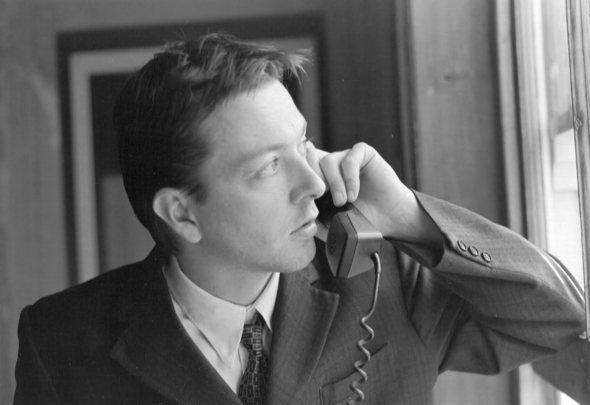
Following (1998)
Memento’s dual structure revolves around the disjunct between the delusional revenge narrative that the amnesiac Leonard Shelby has designed for himself and the hidden narrative – that of a man who deliberately forgets the truth in order to have a reason to live. On Following, the script – about a writer who follows strangers in search of stories – was devised in such a way that if money ran out, what remained would still amount to a story in itself, thus neatly solving the problem faced by many aspiring directors of being caught in the limbo between short film and feature.
Nolan’s interest in coexistent or parallel narratives reaches its apotheosis in Inception, a work of dazzingly pure metafiction, where the creation of the dream functions as an exploration of the artistic method – a revelation of narrative within narrative that hints at endless microcosmic and macrocosmic expansion.
Orson Welles once said that a successful artist should know the limitations of their form, and while Nolan knows these limitations, he also knows what to place at the boundaries to give the impression that the limitations don’t exist. In Inception, using Escher’s stairway as a model, the dream-architect Ariadne (Ellen Page) constructs illusions at the edges of her maze to disguise the limits of the dream experience, just as Nolan uses scenes of deliberate ambiguity to suggest that the architecture of the film might go on forever, in all directions.
In The Prestige, the feedback loop created by the replicating machine means we can never know if it is the real Angier (Hugh Jackman) who dies at the end of the film or one of his ‘replicas’. In fact, given the infinity of ‘replicas’ the machine can produce, we can never truly know if he has died at all.
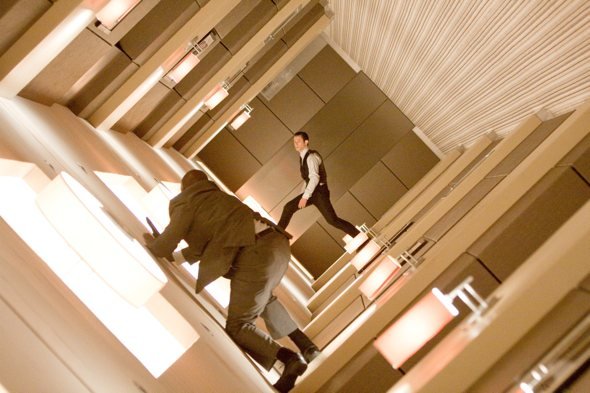
Inception (2010)
Nolan’s ability to stack various structures on top of one another is the key to keeping such mind-testing and structurally ambiguous plots accessible. Ultimately Memento and Inception have Hollywood dynamics at their heart, with turning-points and cathartic climaxes. The complexity of the films always allows room for traditional set pieces and chase scenes such as Dormer’s run across the logs in Insomnia or Cobb’s charge through the streets of Mombasa in Inception.
Yet as with Hitchcock, few elements in a Nolan film have one exclusive function, so even these chases operate as revelations of character: Dormer is determined but tired, and on an unstable footing; Cobb is unable to distinguish between dream and reality, and ends up in an alleyway that shrinks to crush him. In an early scene in Memento, Leonard Shelby’s entire psychological predicament is outlined by cutting straight into the middle of a chase scene – “Right, I’m chasing this guy. No… he’s chasing me!”
These multi-layered narratives work through visual acuity and brisk editing – and an unusual degree of trust placed in the audience to follow the story. This can involve massive compression of scenes – in the prologue of Batman Begins, Nolan takes us with an insistent economy from Bruce Wayne’s encounter with a cave full of bats to his parents’ death, acknowledging the audience’s familiarity with the story while at the same time rendering it anew.
He also implements a counterintuitive editing style of cutting away quickly from what in a standard blockbuster would be the money shot – such as the edit that finally silences the cackling of the joker in The Dark Knight, cutting him off abruptly so his final laugh sounds more like a squeal of pain.
Editing is also used to represent psychological states and merge the characters’ subjectivity with that of the audience. (Since Batman Begins, Nolan’s films have been edited by Lee Smith, otherwise best known for his work with Peter Weir.) Taking the term flashback literally, Nolan intercuts near-subliminal images to suggest Dormer’s guilty recollection of past events in Insomnia, or to show us a young Bruce Wayne’s fear at the bat-like figures tumbling from the opera-house ceiling in Batman Begins.
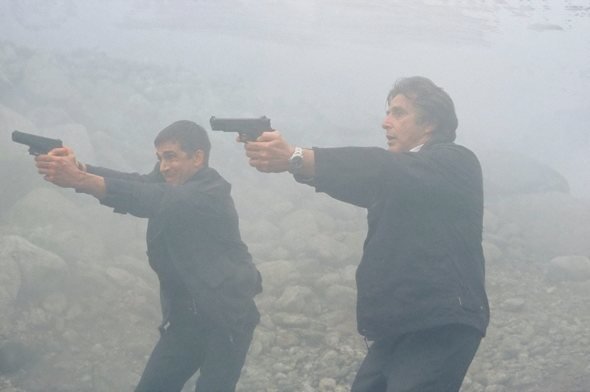
Insomnia (2002)
In scenes of disorientation – as when Dormer is lost in the fog in Insomnia – the editing comes close to abstraction, as it does in moments of perceptual distortion, with camera tricks, ambient sound and subtle CGI used to summon the hallucinations inflicted and suffered by the Scarecrow in Batman Begins. (Nolan’s long-planned Howard Hughes biopic, if ever realised, may offer a shift to more adult subject matter. Yet his intention to concentrate on the last stages of the reclusive millionaire’s life suggests that this too could be a chance to convey psychological conditions such as obsessive compulsion and paranoia.)
While most action directors foreground violence, Nolan uses it tonally. The hyper-edited fights in the Batman films suggest rather than show impact. True, by halfway through The Dark Knight, the Joker has stabbed someone in the face with a pencil, disfigured a gangster rival with a knife and forced two henchmen to death-match each other with broken pool cues. Yet the presentation of these events is edited to make the suggestion of violence paramount – we don’t see a drop of blood.
Nolan’s cinema is driven by a need to entertain the frustrated innocent – the person who first loved movies, comics, books and games in their youth – and to help them transcend the limitations of ordinary existence, of adulthood. Whatever the implications of such high-functioning escapism, Nolan has yet to dishonour his pact with his fans. As Angier puts it at the end of The Prestige: “The audience knows the truth: the world is simple. It’s miserable, solid all the way through. But if you could fool them, even for a second, then you can make them wonder. Then you get to see something really special… It was the look on their faces.”
-
Sight & Sound: the August 2012 issue
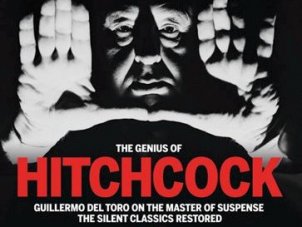
The genius of Alfred Hitchcock: Guillermo del Toro on the Master of Suspense; plus Christopher Nolan, Patricio Guzmán, Bruce Lacey, Boris Barnet,...
-
The Digital Edition and Archive quick link
Log in here to your digital edition and archive subscription, take a look at the packages on offer and buy a subscription.




